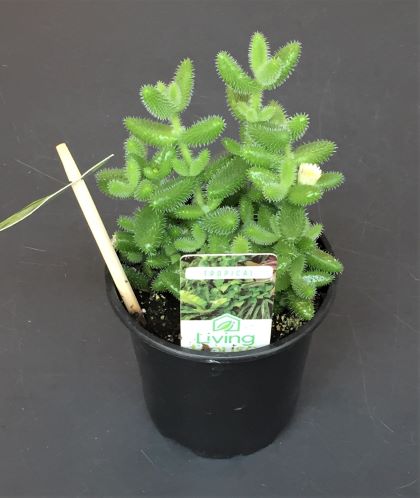How To Grow and Care for the Adorable Pickle Plant
With its plump, little gherkin shaped leaves, Delosperma echinatum, also known as the Pickle Plant, is simply too cute for words. Come learn how to care for and propagate a pickle plant!
Just looking at these adorable little fellows can easily bring a smile to your face. I know it certainly does mine. One of the great things about pickle plants is that if you give them the right conditions, caring for them is a simple process.
Quick Growing Guide
Botanical Name: Delosperma echinatum
Sun / Shade:
Soil:
Height:
Care:
As you’ve likely guessed, pickle plants get their common name from the shape of their leaves – which look like little pickles. Though the leaves are covered with tiny, white, thorn-like hairs, there’s no need to worry. Unlike a cactus, pickle plant hairs are soft to the touch. So, no ouchy fingers with these guys.
Pickle plants are low growing succulents that have a shrub-like appearance. However, the leaves, which grow on thin, wiry stems, can reach heights of 18” – 20”. In the spring they produce small, daisy like flowers of white or yellow.
Because of their unique look, mature plants can make a nice option for a hanging basket.

Watering the Pickle Plant
When it comes to pickle plant care, proper watering is probably the most critical task.
As a succulent, a pickle plant doesn’t require heavy watering. It’s important to give your plant good water, then let the soil dry out before watering again.
Overwatering a pickle plant can quickly lead to its demise. And, I’m sad to say that I have been guilty of this myself.
The first time I bought a pickle plant, I didn’t pay close enough attention to the dampness of the soil. The result? The leaves looked green and full one day, and completely deflated the next. Without realizing it, I had overwatered my plant. Needless to say, this was a lesson learned.
When it comes to watering your pickle plant, you’ll water him more often during the hot summer months – perhaps every week to week and a half. In the winter, you’ll reduce your watering schedule to roughly every 3 weeks.
If you notice the leaves starting to get a bit droopy and soft, that’s a good sign that it’s time to water again.
Lastly, don’t let your plant sit in water. That’s definitely one way for him to become too waterlogged.
If you’d like to know a little more about how to water succulents in general, check out this article from Succulents and Sunshine.
Light and Temperature
Delosperma echinatum are native to South Africa. So they like bright, sunny spots with lots of indirect light. A west or south facing window is your best option for these guys.
Pickle plants are perennials and, in warmer climates, can be grown outdoors. However, although they are more cold tolerant than many succulents, they won’t survive a hard frost. Additionally, they can be considered invasive ground cover. So, take these facts into consideration if you’re thinking of a pickle plant for a garden bed.
Up north, where pickle plants make great little houseplants, they’ll do fine in a spot with a moderate temperature. And as with most houseplants, try to keep him away from cold, drafty areas.

Soil Considerations for Delosperma echinatum
Although pickle plants aren’t super fussy about their soil, if you want your plant to really thrive, use a rich, well-draining soil. A cactus-like or succulent soil mixed with coarse sand or perlite is a good option.
Pickle Plant Propagation
The easiest way to propagate a pickle plant is from cuttings. And, luckily, the process is fairly simple.
Using a clean, sharp pair of pruners or scissors, I carefully snip several cuttings, about 2.5” – 3” long. Next, remove the bottom leaves from each cutting. Once this is done, wait a day or two to allow the cuttings to callous over a bit. Then, replant them in well-draining soil.
See, easy peasy! Cuttings can be taken in spring, summer, or fall.
Maintenance
With proper soil, water and light, your pickle plant will not need much maintenance.
Luckily, pickle plants don’t require repotting very often. In general, plan every couple of years for this task. Always make sure your pot has good drainage. In addition, choose a pot that is only a size or two larger than its current home.
Indoors, there’s really no need to prune your plant. However, if you live in a southern climate and are planting outdoors, you might want to consider pruning to keep your plant from spreading. This should be done in the spring.
Overall, pickle plants are pretty resistant to pests and disease. Of course, as with any houseplant, you’ll want to keep an eye out for signs of either. These can include yellowing or damage to the leaves or stems, signs of webbing or actual insects, or the plant is just generally looking poorly for no other reason. If you suspect a pest or disease, treat it immediately.
Toxicity
Another great feature of the pickle plant is its non-toxicity. Which makes them a great option if you have any concerns with pets or young children.
In Conclusion
Well, there you have it! This adorable plant makes a unique addition to any houseplant collection. And because pickle plant care can be low maintenance, they make wonderful choices for plant parents who are short on time.







Leave a Reply
You must be logged in to post a comment.